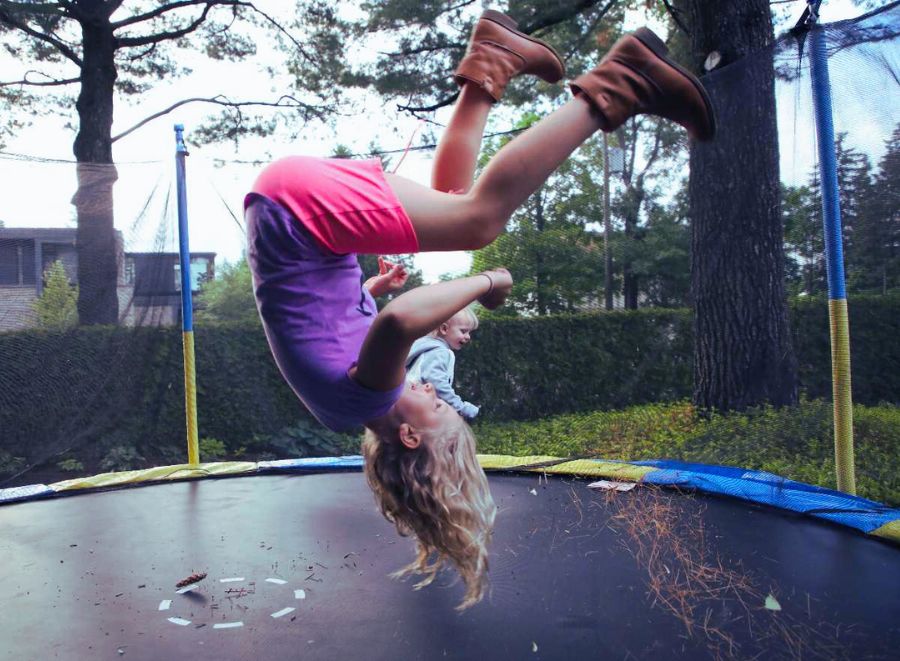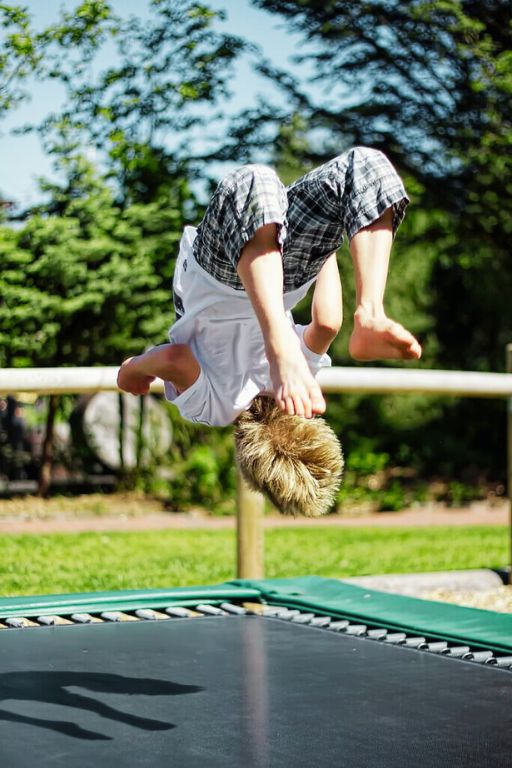Trampolining is a popular recreational activity enjoyed by many people worldwide. However, there are concerns regarding the safety of trampolines, especially in relation to brain health and potential brain injuries.
This article will explore the mechanics of trampolining, highlight the physical benefits, discuss risks and safety, examine scientific research, and look at whether trampolining may be detrimental to brain health.
The Mechanics of Trampolining
A trampoline consists of a sturdy frame supporting a durable, stretchy surface made of fabric and steel springs. As a person jumps on the trampoline, their weight causes the surface to sink down, stretching the springs. The springs then contract to bounce the jumper back up in the air. This creates a rebounding effect that enables the person to reach greater heights than with normal jumping.
Trampolines come in different shapes, sizes, and types, from mini exercise trampolines to large recreational trampolines. They may have safety pads covering the springs and frame, with some models featuring enclosures with netting to prevent falls. Safety recommendations include allowing only one person at a time, using spotters, avoiding flips and somersaults, and having adequate overhead clearance.
Physical Benefits of Trampolining
Trampolining provides an effective cardiovascular workout that can strengthen muscles throughout the body. As a low-impact exercise, it places less stress on joints than many other activities like running. Specific benefits include:
- Increased heart rate for cardiovascular conditioning
- Toning of core muscles in the abdomen and back
- Building leg strength through repeated squatting and jumping
- Improving balance and coordination
- Burning calories for weight loss
Trampolining is commonly used for fitness training, sports conditioning, and even rehabilitation after injuries. It can be enjoyed recreationally or competitively in trampoline gymnastics and diving events. With its aerobic and muscle-strengthening advantages, trampolining offers an efficient total body workout.
Common Activities on Trampolines
In addition to simple bouncing, trampolines are used for a variety of skill-based activities:
- Trampoline Gymnastics – Performing somersaults, twists and acrobatic routines. This may involve single, synchronized, or double mini-trampolining in competitions.
- Recreational Games – Playing games like trampoline dodgeball or basketball involves coordination, agility and strategy.
- Aerial Fitness – Specialized aerial and acrobatic exercise classes utilize trampolines to achieve greater height for moves like flips, jumps and drops.
- Trampoline Parks – Large indoor trampoline parks feature interconnected trampolines, pits of foam cubes, climbing walls and obstacle courses.
While thrilling, these activities require proper training and supervision to be conducted safely. Over-exertion, poorly executed maneuvers and collisions increase injury risks.
The Importance of Brain Health
The brain is the body’s central control system, coordinating vital functions like breathing, heartbeat, movement, emotions, and cognition. As the most complex organ, proper brain health and function is essential to overall well-being.
The brain can be affected by genetics, nutrition, stress, sleep, drug and alcohol use, aging, and head trauma. Protecting the head from blows and jolts helps prevent damage. Even mild brain injuries may cause cognitive, behavioral or coordination problems. More severe trauma can be permanently disabling or even fatal.
While the brain has some ability to rewire neural pathways and compensate after injury through neuroplasticity, damage cannot always be repaired. So preserving brain health through safety awareness in daily life is paramount.
Risks of Physical Activities on Brain Health
Physical activities provide mental and physical health benefits, but also inherent risks depending on the nature of the activity. Contact sports and extreme sports are associated with higher rates of concussions and head injuries due to collisions, falling from heights, and impacts.
Sports with high rates of brain injuries include football, boxing, hockey, skateboarding, skiing, snowboarding, and gymnastics. Trampolining would fall into the high-risk category as an extreme sport where users are propelled high off the ground while flipping and twisting.
Safety gear like helmets in skiing and cycling can help prevent brain injuries to some degree, but cannot fully protect the brain from forceful, repetitive jolts in high-risk activities. All physical activities should be approached with safety as a priority.
Potential Brain Injury Risks Specific to Trampolines
While trampolining can improve strength, balance and coordination when done properly, uncontrolled bouncing carries risks:
- Falling off – Landing off the trampoline onto hard surfaces can cause traumatic brain injuries and fractures.
- Collisions – Multiple users bouncing simultaneously may collide in mid-air or land on each other, causing trauma from direct blows.
- Attempting flips – Somersaults and aerial tricks without proper skill level can result in crashes, especially on standard recreational trampolines which have less lifting power than gymnastic trampolines.
- Striking the frame or springs – Users may hit the metal frame or springs if unable to control their body position, causing blunt force trauma.
- Insufficient overhead clearance – Makes contact with ceilings, tree branches or other structures above more likely, causing trauma directly to the head.
These factors demonstrate how the high-flying nature of trampolining carries significant risks of falls, collisions and body control issues that can damage the brain. Safety measures are essential.

Common Brain Injuries in Trampoline Accidents
Trampoline accidents frequently cause injuries to the head and brain due to the jarring impacts and sudden decelerations involved. Common brain injuries include:
- Concussions – The brain makes forceful contact with the interior skull, bruising brain tissue and nerve fibers. Causes headaches, dizziness, confusion and cognitive problems. Multiple concussions have a cumulative effect.
- Contusions – Bruising of brain tissue that can lead to swelling, impaired function, and permanent damage in severe cases due to bleeding in the brain.
- Diffuse Axonal Injuries – Stretching and tearing of nerve fibers throughout the brain disrupts neural communication. Results in concussion symptoms plus loss of coordination and balance issues.
- Hemorrhages – Ruptured blood vessels in the brain allow blood to accumulate, placing dangerous pressure on brain tissue. Can be life-threatening.
- Skull fractures – Cracks or breaks in the skull may extend through the brain’s protective covering, allowing infections or injuries to brain tissue underneath.
These brain traumas require rapid medical attention and can have lasting neurological effects or even prove fatal if not properly treated. Proper safety practices are key to avoiding trampoline accidents resulting in such hazardous injuries.

Trampoline Safety Measures
While trampolining does carry risks, there are safety practices that can help reduce the chance of accidents and injuries when jumping. Following guidelines and using common sense goes a long way in keeping recreational trampolining safer for brain health.
Overview of Safety Guidelines for Trampoline Use
Safety organizations like the American Academy of Orthopedic Surgeons recommend these trampoline safety guidelines:
- Only allow one person to use the trampoline at a time. Multiple simultaneous jumpers increase risks.
- Adult supervision is recommended for children under 6 years old. Do not leave young jumpers unattended.
- Place trampolines away from structures, trees, pools, swings and fences to prevent collisions and provide ample overhead space.
- Use trampolines with safety net enclosures to prevent falls off the sides.
- Do not attempt flips, somersaults or complicated tricks, especially on recreational trampolines lacking proper gymnastic lift.
- Inspect trampolines before each use and replace any worn, damaged, or missing parts.
Following these common-sense precautions goes a long way in reducing risks of dangerous falls and injuries during recreational bouncing.
The Importance of Supervision and Monitoring
Vigilant supervision and monitoring of jumpers is key, particularly for young children who may engage in risky behavior. An adult should maintain active oversight and enforce safe practices. This includes:
- Prohibiting multiple users at once
- Preventing poorly executed flips or tricks beyond skill level
- Ensuring sufficient clothing and/or padding is worn
- Maintaining vocal contact and offering guidance
- Watching for signs of exhaustion or loss of control
With active supervision, an adult can promptly intervene at the first sign of danger and reduce the chance of accidents. Jumping alone without any monitoring is never recommended.
Protective Gear and Other Precautions
In addition to supervision, personal safety gear can add protection:
- Helmets – Can protect the skull from direct blows and may reduce concussion severity, though limited for high-speed impacts.
- Face masks – Help protect facial bones and teeth from fractures and trauma.
- Padded gloves – Absorb force from landing impacts transmitted up the arms.
- Goggles – Keep eyes safe in case foreign objects like grass enter the trampoline area.
- Bright clothing – Enhances visibility for spotters monitoring jumpers.
Other precautions like anchoring the trampoline, using high-quality protective pads, allowing only one person at a time, and prohibiting aerials and flips also help minimize risks. Safety-first mentality is essential.
The Role of Personal Responsibility
While safety guidelines exist, individual jumpers also need to take personal responsibility for managing risks. Key responsibilities include:
Educating Themselves on the Risks
Before hopping on a trampoline, take time to learn about injury risks, common trampoline accidents, and how to jump safely through training. Unsafe actions like flips without training or bouncing near structures demonstrate poor judgment and disregard for hazards.
Knowing Personal Limits
Honestly assess physical capability before attempting challenging skills. Work up slowly to more advanced aerial maneuvers once basic jumping skills are mastered. Know when to call it quits when exhausted. Don’t let ego or peers push you beyond your abilities.
Maintaining Self Control
Avoid getting carried away with rambunctious jumping or stunts that can lead to collisions and falls. Remain focused on controlled, centered bouncing to better react to hazardous situations and avoid injuries.
While supervision, pads and warnings help protect users, learning about risks and demonstrating maturity ultimately rests on the individual’s shoulders as well. Taking responsibility for personal safety goes hand in hand with trampoline education programs.
Who Should Not Use a Trampoline?
There are some groups at much higher risk who should avoid trampoline use completely:
- Children under 6 years old – Lack adequate coordination and judgment skills.
- Individuals with medical conditions – Such as heart conditions, joint problems, or inner ear issues affected by bouncing.
- People under the influence of drugs or alcohol – Impaired reflexes and judgment increase risk.
- Anyone not willing or able to follow safety rules – Such as flips, staying centered, not overexerting, etc.
For higher-risk groups, the hazards clearly outweigh any benefits of trampoline use, and abstinence is advised.
Conclusion
While trampolines do present falling and collision risks that can result in brain injuries, following safety best practices can help reduce dangers substantially. Staying focused, avoiding flips, using protective gear, proper adult supervision for kids, and not using trampolines when impaired are all key precautions.
Ultimately trampoline users must educate themselves on risks, know limits, and take responsibility for personal safety. With knowledge, maturity and precaution, the benefits of trampolining can be enjoyed with careful management of risks to support brain health.
Frequently Asked Question
Can bouncing hard on a trampoline give me a concussion?
Yes, bouncing vigorously on a trampoline can potentially lead to a concussion. The impact from repeated bouncing, flips, or falls can cause the brain to hit the inside of the skull, resulting in a concussion.
Whenever I jump on the trampoline, it feels like my brain is shaking up and down, why does it happen?
Feeling like your brain is shaking when jumping on a trampoline is often due to the rapid up-and-down movement, causing the brain to move within the skull. This sensation is similar to what happens when you experience turbulence on an airplane. The brain is protected by cerebrospinal fluid, but intense bouncing can still create this sensation. It’s essential to be cautious and avoid excessive jumping if this feeling persists or worsens, as it could potentially lead to injury.
Do trampolines cause brain damage?
No, trampolines don’t typically cause brain damage. While injuries can happen, the risk is minimal when proper safety precautions are followed. Most injuries result from falls or collisions, not direct impact on the head. To reduce the risk, ensure a safety net is in place, supervise users, and avoid stunts.
Does jumping on a trampoline affect long-term in the brain?
Jumping on a trampoline can actually be beneficial for the brain in the long term. It stimulates the release of neurotransmitters like dopamine, which enhances mood and cognitive function. Regular trampoline activity can improve coordination, balance, and spatial awareness, contributing positively to brain health over time.
Last Updated on February 13, 2024

